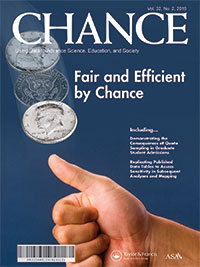Can a Statistical Concept Help Solve Political Gridlock?
Scott Evans, CHANCE Editor-in-Chief
The United States has perhaps never been so entrenched in political gridlock. Negotiations over issues such as health care and immigration are at a stalemate. Might we look to a statistical concept to play a role in addressing these issues? Could randomness be part of the solution? Leonard Wapner discusses whether flipping a coin can help address the country’s problems in “Fair and Efficient by Chance.”
Graduate admission to STEM-related programs at universities in the United States often apply a quota system to ensure applicants from the United States are accepted when competing against a talented international pool of applicants. Paul Kvan discusses the implications of this in “Demonstrating the Consequences of Quota Sampling in Student Admissions.”
Statisticians understand that point estimates should be accompanied by standard errors or the precision associated with such estimates. But, in many cases, tabular summaries are published without this information. Tom Krenzke and JianZhu Li describe an approach, “replicating tables,” that allows sampling errors from a table based on the margins of error associated with numbers in the table to carry into analyses that use this information. An R function and Excel file can be used to implement the approach.
In our columns, Monika Hu shares a rewarding experience about teaching an upper-level undergraduate statistics course through a shared/hybrid model in Taking a Chance in the Classroom. Mine Çetinkaya-Rundel revisits teaching massive open online courses and what we have learned from them in Teaching Statistics in the Health Sciences. Nicole Lazar discusses crowdsourcing in the big data era in The Big Picture. Christian Robert reviews The Beauty of Mathematics in Computer Science, IAQ, Let the Evidence Speak, Is That a Big Number, and Surprises in Probability—Seventeen Short Stories in Book Reviews. Finally, Howard Wainer examines the work of Devah Pager in Visual Revelations and discusses her work on the relative effects of race and crime on employment.
Finally, have fun visualizing the connection between a box plot and the human face, thanks to Sarjinder Singh.
Be sure to reserve Saturday, September 28, for the next installment of the New England Symposium on Statistics in Sports (NESSIS), one of the pre-eminent research conferences on statistics in sports.


















